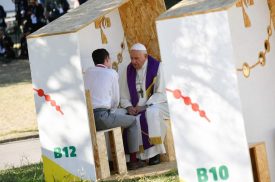A Mission of Mercy (John: 19-31)
In the bible, the number forty is usually associated with a period of preparation. Following the forty days of Lent preparing for Easter, there are forty days between the Resurrection and Ascension. My very young grand-nephew asked me a deep question one day. “Where was Jesus in the time between his Resurrection and Ascension?” All I could say was that he came back on several occasions to strengthen the faith of his disciples. “For forty days he had continued to appear to them and tell them about the kingdom of God.” (Acts 1:3).
It was a week since the day of Resurrection, but the apostles were locked behind closed doors, not knowing what to do, confused and afraid (John 20: 19-31). There is an old Irish saying that God’s help is closer than the door. The Risen Lord appeared in that room of fear. He showed them his wounded hands and side. He is recognised in his wounded condition. Possibly the wounds stirred the memory of the words of Isaiah, “Ours were the sufferings he bore, ours the sorrows he carried. By his wounds we are healed.” He is the wounded sacrificial Lamb who takes away the sins of the world. He told them “As the Father sent me, so am I sending you.” The mission he gave them was to continue his ministry of mercy in the forgiveness of sins. How could they perform this divine work? It would be in the power of the Holy Spirit. He breathed the divine power on them. “Receive the Holy Spirit. For those whose sins you forgive, they are forgiven; for those whose sins you retain, they are retained.” Retaining means calling a sin a sin and telling people that divine mercy is being blocked until they humbly repent of their wrongdoing. The message for Christians down the ages is to recognise the presence of God in the forgiveness of sins.
Doubting Thomas
The Apostle Thomas was missing that day. He resolutely refused to believe what the others told him about the Lord’s appearance. He was so loyal to Jesus that he once declared that he was willing to go to Jerusalem with him and die with him. But he was loyal to a fault. Loyalists, political or religious, find it very hard to accept change. He was so loyal to the former days of knowing Jesus physically that he was not ready to know him by faith instead of physical recognition. When the Lord appeared the following Sunday, he invited Thomas not only to see his wounds but to touch them. Touching the wounds is very significant because it suggests getting in touch with any wounded part of our inner self. The steps in a rehabilitation programme begin with getting in touch with the inner wounds of life. The humble admission of an inner hurt or an uncontrolled addiction involves touching the wounded area. Then it is handed over to the Higher Power. And there is no Power higher than the Saviour who knows suffering from the inside because he has experienced it personally. He achieved the ultimate victory when he conquered death itself by rising from the dead.
The story of Thomas is a wonderful example of how our very wounds can be the place where we get the grace of knowing that the Lord is nearer to us than the closed door. I have met many people in recovery who have developed a powerful prayer-life.
Prayer
Risen Lord, you are with us on the road of life even when, like the disciples on the road to Emmaus, we are going in the wrong direction. Stay with us, and when we fall into sin, cleanse us in the Sacrament of Divine Mercy. Sustain us in Holy Communion, the Bread of Life.
When we are struggling with wounds and problems, grant us your help which supports us and heals us. Alleluia!


